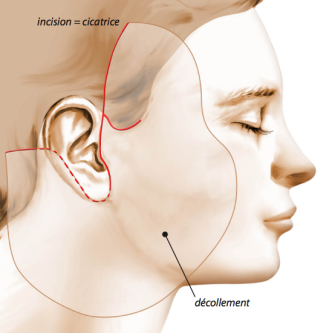This fact sheet was developed under the aegis of the French Society of Plastic Reconstructive and Aesthetic Surgery (SOF.CPRE) as an addition to your initial consultation, to try to answer all the questions you can ask yourself if you plan to use a facelift. The purpose of this document is to provide you with all the necessary and essential elements of information to help you make your decision with full knowledge of the facts. Also you is it advisable to read with the greatest attention.

This procedure can be associated with another gesture facial aesthetic surgery: eyelid surgery (blepharoplasty), correction of the collapse of the lateral portion of the eyebrow correction and crow's feet (temporal lift), correcting the sagging and wrinkles on the forehead (conventional or endoscopic brow lift). It can also be supplemented by medical and surgical therapies (laserbrasion, dermabrasion, peeling, hyaluronic acid injections, botulinum toxin).
In your discussions with the surgeon, it is important to report to any imperfections that you want to improve or disappear. Having understood your request, it will be your guide in the assessment of future earnings and techniques to use.
It may possibly advise you not intervention or offer alternatives.
BEFORE THE OPERATION
A usual preoperative assessment is conducted in accordance with regulations.
The anesthetist will be seen in consultation at least 48 hours before surgery.
No medication containing aspirin should not be taken within 3 weeks prior to surgery.
Smoking cessation is strongly recommended at least one month before and 15 days after surgery.
Smoking increases the risk of postoperative complication of any surgery. Quit 6 to 8 weeks before surgery removes the excess risk.
If you smoke, talk to your surgeon and your anesthesiologist. You can also call Tobacco-Info-Service (3989) to help you reduce risk and put all the chances on your side.
It will be performed by washing the hair the night before and the morning of surgery and careful cleansing the day of surgery.
It is essential to continue fasting (nothing to eat or drink) 6 hours before surgery.
TYPE OF ANESTHESIA AND CONDITIONS OF HOSPITAL
Type of anesthesia: The head and neck lift can be performed under general anesthesia or local anesthesia depth by tranquilizers administered intravenously (anesthesia "vigil").
The choice between these techniques is the result of a discussion between you, the anesthetist and the surgeon.
Terms of admission: A hospital 24 to 48 hours is usually necessary.
INTERVENTION
Each surgeon adopts a technique of its own and it adapts to each case to obtain the best results. However, it may hold common basic principles:
The incision is largely hidden in the hair and around the ear.
Starting of incisions, a separation is made in the skin, and its extent depends on the individual case, in particular the importance of tissue relaxation.
This is followed by an extremely precise dosage and retightening the musculoaponeurotic plan to correct the deep slump, while maintaining its natural facial expression.
In case of localized excess fat, liposuction or tummy tuck is performed with scissors in the same operation: it can act on the neck, chin, jowls and cheeks. Conversely, a loss of volume, the addition of fat (the) patient (e) (lipostructure) will often prove effective hamoniser the final result.
The redraped skin comes naturally fit the shape created by the muscular mobilization, lipostructure or liposuction. The excess skin is removed, sutures made without tension.
After surgery, most surgeons perform a dressing that goes around the head.
The facelift in humans has some features (thicker skin, moving hairy areas, more sparse hair less discreetly hiding scars) that your surgeon will speak.
Depending on the surgeon, the importance of the corrections and any associated actions, the procedure can last from two to four hours.
AFTER THE INTERVENTION: THE OPERATING SUITES
The output may act as either the next day or the day after surgery.
The first 10 days must rest up and avoid exertion.
During those early days, the operated (e) must not be surprised or concerned:
- Of edema (swelling), which can be more pronounced on the second day than the first,
- Bruises (blue) in the neck and chin - a feeling of painful or unpleasant tension, especially behind the ears and around the neck.
These bruises and swellings disappear the average within 2 weeks postoperatively.
After the first month, the swelling has almost disappeared in general. But there is still a slight induration of the detached areas, more palpable than visible. The ears and cheeks will return to their normal few months later sensitivity.
Sometimes you can see for several weeks or months after surgery, discomfort, tension fabric, gravity a little unpleasant, which eventually disappear.
The scars are hidden in back and forth by the che-like. The only visible area slightly in front of the ear lobe, may be temporarily masked by the make-up or hair.
Schematically it is:
- The fifth or sixth day, presentable for friends,
- To the twelfth day presentable for his friends,
- But to look at the people who we want them to know the operation, it is necessary to provide three to four weeks, in the absence of incidents.
THE RESULT
After one to three months, we can get a good idea of the final result. But the scars are still a little pink and indurated and fade as to the sixth month.
Thanks to progress in both support before and after the intervention in the technical medical-surgical gicales a rejuvenating effect significant, which remains very natural yields: the face is not a "surgical" appearance and found approximately traits that were his eight or twelve years ago, which gives a whole rested appearance, relaxed and refreshed.
The physical improvement is accompanied by a general psychological wellness.
The goal of this surgery is to make an improvement and not to achieve perfection. If your wishes are realistic, the result should give you great satisfaction.
In the long term, the cervical-facial lifting has to fight against the ravages of time, but aging continues to do its work and it may possibly consider a new type of intervention facelift after a decade .
Current techniques used to repeat the intervention if necessary beyond this deadline. However, this perspective with must enroll in an interview face with lighter complementary techniques delaying Ront all-new action they have been carried out regularly.
DISAPPOINTING LOSS
It can be essentially:
• of edema (swelling) persistent in some areas beyond the third month and may require massage
• a partial reproduction of the relaxation of tissues, including the anterior part of the neck, when the ptosis was important before surgery, • too visible scars or hair loss localized in the region of the temples (alopecia) that can require surgical editing distance (six months to a year).
POSSIBLE COMPLICATIONS
The cervicofacial lift, although made mainly for aesthetic reasons, none the less a real surgery, which involves the risks associated with any medical procedure, however small it may be.
We must distinguish the complications of anesthesia and those related to the surgery.
Regarding anesthesia, during the consultation, the anesthetist inform himself (the) patient (e) of the anesthetic risks. You should know that anesthesia in the body sometimes unpredictable, and more or less easy to control: having recourse to Anes care professional fully qualified, practicing in a con-text that is actually surgical risks are statistically very low.
Indeed, techniques, anesthetics and monitoring methods have made tremendous progress over the past thirty years, providing maximum security, especially when the operation is performed outside of the emergency in a person healthy.
Regarding surgery: choosing a qualified and competent plastic surgeon, trained in this type of surgery, you limit these risks, without removing them completely.
Fortunately, postoperative generally simple with the waning of head and neck lifting done in the rules, and real complications are rare.
In practice, the vast majority of happens without any problems and the patient (s) are satisfied (s) of their results.
However, despite their rarity, you must be informed (e) of the possible complications:
• A hematoma may require rapid evacuation.
• A pain or skin necrosis, re-sponsible for delayed healing (the risk is increased by tobacco intoxication).
• The infection is exceptional.
• Nerve damage: injury to a branch of the facial nerve, which may cause paresis or facial palsy is exceptional and the effects go more often within a few months. More rarely, may occur paralysis of the spinal nerve (nerve of shoulder elevation).
• The market-alkaloids or abnormal scars, hypertrophic of appearance and unpredictable changes can affect the appearance of the result and require specific local treatments sometimes extended.
In total there should not overstate the risks, but simply aware that surgery, even seemingly simple, still a small share of hazards.
The use of a qualified Plastic Surgeon ensures that it has the training and skill required to avoid these complications, or effectively treat as appropriate.
These are the pieces of information that we wanted to bring you in addition to the consultation. We recommend that you keep this document, read it again after the consultation and reflect "a clear head." This reflection may raise new questions for which you wait for additional information. We are available to talk during the next consultation, or by phone, or even on the day of surgery when we meet in any way before anesthesia.

DEFINITION
Today there are several types of facelifts that improve the misfortunes caused by aging of the face and neck, is so localized, or more extensively.
The cervicofacial lift is most commonly done, it is the surgical correction of aging in the neck as well as the face region from the temples to the region of jowls.
This cosmetic surgery can not be supported by health insurance.
OBJECTIVES
The treat sagging operation aims and relations mation of the skin and muscles of the face (forehead and eyebrows, cheeks, jowls, oval face) and neck but also the lack or excess fatty tissue. The purpose of such intervention is not to change the shape and appearance of the face. Instead, the simple restoration of various anatomical structures of the face and neck (skin, muscle, fat) allows the effected (e) to find the look that was hers a few years ago.
PRINCIPLES
The muscles are returned to voltage, in order to correct their release. The skin is then redraped demand on new contours without excessive traction. This dual action provides a natural result (because the skin is not pulled too), durable (because the plan is solid muscle), surgical suites usually quite simple (skin "brand" less because it bit is traumatized due to the limited voltage and peeling). Overload any fat can be treated by liposuction.
Conversely, if the face is gaunt, this aspect can be corrected at the same time by re-injection of autologous fat (lipostructure). And the face and neck are somehow "reconstructed", "restructured".
In contrast, expression lines, wrinkles, crow's feet or peri-oral wrinkles are not changed.
Deep wrinkles are improved by the tension on the skin without ever completely disappear.
The appearance of the eye is not corrected by a facelift Cervicofacial isolated.
The skin incisions are necessary essentially hidden in the hairy leg or hair (at the temples and neck) and around the ear. The scar is thus almost completely hidden. The head and neck lift can be performed as soon as the signs of aging appear (loosening the cheeks, neck, degradation of facial lines) and a correction request is made reasons, usually from 40 to 45 years.
FACE LIFT
AESTHETIC PLASTIC
& RECONSTRUCTIVE SURGERY




© Docteur Garson MAJ 2013